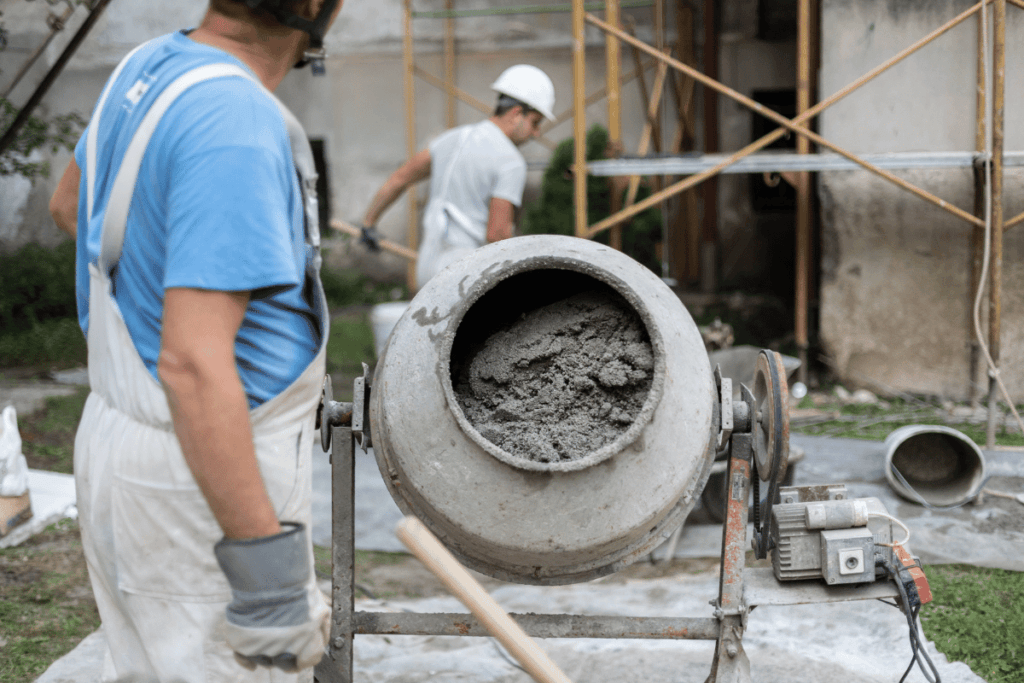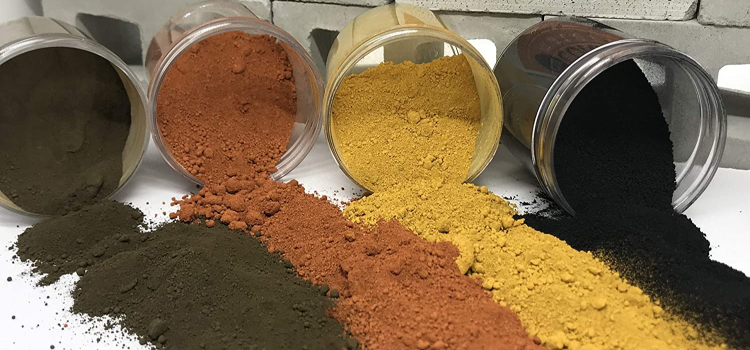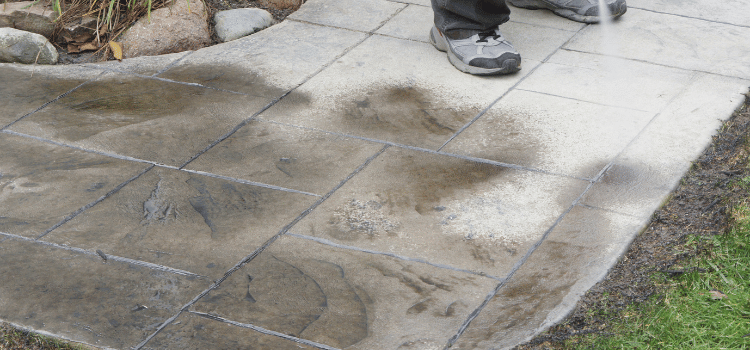This journey into concrete composition began centuries ago, with its primitive forms gracing the infrastructure of ancient civilizations. Today, it has evolved into a sophisticated mix, tailored for strength, durability, and versatility. So what is concrete made of and how has it changed over the years?
My objective is to demystify the seemingly complex makeup of concrete and break it down into understandable parts for everyday knowledge.
So why should you care about what’s in concrete? Knowledge of its composition not only informs construction professionals but also empowers homeowners, DIY enthusiasts, and curious minds. It enables you to understand the robustness of the buildings you dwell in, the bridges you cross, and the pavements you walk upon.
What Is Concrete Made Of: A Closer Look at Concrete’s Ingredients

A comprehensive grasp of the fundamental elements comprising concrete sheds light on why this material is favored by builders worldwide. Concrete is not a mysterious blend; rather, it is a reliable amalgamation of three essential components:
Cement: Often mistaken for concrete itself, cement is a crucial binding ingredient. This powdery substance initiates the chemical reaction of hydration when mixed with water, leading to the solidification of the entire mixture.
Aggregates: Comprising sand, gravel, or crushed stone, aggregates form the majority of concrete and contribute to its compressive strength. They play a vital role in determining the overall characteristics of the resulting concrete.
Water: Beyond its role as a facilitator for mixing, water acts as the activator of the cement and triggers the hardening process. It is a key factor in shaping the final properties of the concrete.
The proportions in which these materials are combined can vary significantly, resulting in different types of concrete suitable for various applications.
For instance, high-strength concrete used in a bridge pier necessitates a higher cement-to-aggregate ratio compared to a basic sidewalk mix, where more aggregate and less cement is employed.
The precise composition of the concrete mix is crucial, influencing aspects such as workability, curing time, and the ultimate strength and durability of the structure.
Understanding the interplay among these components is essential. A well-balanced concrete mix can achieve the desired finish, strength, and lifespan, while an imprecise blend may lead to structural failures or unnecessary expenses. In the next section, I will delve into the realm of cement itself, exploring its types, composition, and its pivotal role within the concrete mix.
Understanding Cement In Concrete

Cement is a remarkable binder in the world of concrete. You and I see its outcome everywhere, from sidewalks to skyscrapers. Cement’s role is to hold together the aggregates through a process known as hydration.
There are various types of cement, each tailored for specific purposes. Ordinary Portland Cement (OPC) is the most widely used.
Other types like High-Early Strength, Sulfate Resisting, and Low Heat types of cement serve more specialized roles.
To understand cement, you should know it’s a finely ground powder. When mixed with water, it forms a paste that hardens and gains strength over time – thanks to a chemical reaction called hydration. This process is crucial to the integrity of any concrete structure.
The environmental impact of cement is a poignant topic. Its production is energy-intensive and contributes to CO2 emissions. However, strides are being made in sustainable production, including the utilization of alternative raw materials and energy efficiency improvements.
Concrete Aggregates and Additives

When you look beyond the gray surface, concrete reveals a diverse world of materials that bolster its strength and usability. Among these, aggregates stand as a crucial component. These varied granules, ranging from sand, and gravel, to crushed stone, are more than just filler; they provide the compressive strength that concrete is known for.
The characteristics of these aggregates are vital. The size, shape, and texture of the particles can dramatically affect the final product’s integrity.
For example, smooth, rounded aggregates make the mix easier to work with, while rough, angular ones often lead to stronger concrete. With varying dimensions, engineers can tailor the concrete to suit the structural demands of different projects.
Beyond aggregates, concrete’s versatility comes to life through additives and admixtures. These substances are intentional extras, included to modify the concrete for specific conditions or requirements. From accelerating the setting process in chilly weather to reducing water content for greater strength, these additions make concrete adaptable to almost any scenario.
Consider how workability, durability, and the prevention of unwanted cracking are greatly influenced by these additional ingredients. Air-entraining agents, for instance, introduce tiny air bubbles into the mix, providing space for water to expand when it freezes, thus reducing the risk of cracking due to freeze-thaw cycles.
Closing this section, remember the fine balance between the aggregates, additives, and the chemistry they bring. It’s this harmony that equips concrete to support skyscrapers, pave vast highways, and underpin the infrastructure that shapes our daily lives.
Water’s Vital Role in Concrete Composition

Water isn’t just a minor component; it’s the catalyst that sets the entire chemical process of concrete hardening in motion. Without water, the other ingredients would remain a powdery mixture without the ability to solidify.
The quality and quantity of water in a concrete mix are not arbitrary choices. They are meticulously calculated to ensure that the hydration process – where cement and water react – proceeds optimally. This reaction is crucial as it directly influences the concrete’s final strength and durability.
Moreover, the water-to-cement ratio is a critical measurement in any concrete mixture. Too much water weakens the concrete, while too little can prevent it from setting correctly. Skilled professionals always aim for the perfect balance to achieve the desired finish and structural integrity.
Understanding this delicate balance underscores why education in material science and proper mix design is indispensable for construction professionals.
In summary, each component of concrete plays an indispensable role in its overall performance. While cement acts as the binder, aggregates provide the structure, and additives enhance properties, water remains the essential ingredient that transforms the potential of the mixture into the concrete reality that builds our world.
Ensuring the correct proportions and quality of these materials is not just a matter of following a recipe; it’s a complex science that, when executed well, leads to the resilient structures that define our built environment.
How Concrete Has Changed Over The Years

Over the years, the evolution of concrete has been marked by transformative changes. Initially devoid of steel reinforcement, early concrete lacked the tensile strength needed for larger structures. The incorporation of steel rebar revolutionized construction, adding crucial reinforcement to withstand greater loads and stresses.
Moreover, advancements in concrete technology have seen variations in aggregate ratios. Different mixes are now tailored for specific applications, from high-strength mixes for heavy infrastructure to more porous formulations for specialized projects. These developments reflect a dynamic history, showcasing concrete’s adaptability and constant improvement in meeting diverse construction demands
Concrete advancements over the years
- Introduction of Steel Reinforcement: Initially absent, the incorporation of steel reinforcement, such as rebar, has significantly enhanced the tensile strength and overall durability of concrete structures.
- Evolution in Aggregate Ratios: Concrete mixes have evolved with tailored aggregate ratios, offering versatility for various applications. This includes high-strength mixes for heavy infrastructure and specialized formulations for specific project requirements.
- Development of Additives and Admixtures: The integration of additives and admixtures has allowed for improved workability, durability, and performance of concrete. These innovations address specific challenges and enhance the overall quality of the material.
- Advancements in Concrete Technology: Ongoing research and technological advancements have led to the development of new types of concrete with enhanced properties, such as self-healing concrete, high-performance concrete, and more sustainable variants.
- Innovation in Formulations for Sustainability: Modern concrete formulations increasingly emphasize sustainability, incorporating recycled materials like fly ash or slag. This eco-friendly approach aligns with contemporary environmental considerations and reduces the environmental impact of concrete production.
Summary Of What Is Concrete Made Of
Concrete is composed of cement, aggregates (such as sand and gravel), and water.
Over the years, significant changes have occurred, including the introduction of steel reinforcement for enhanced strength, adjustments in aggregate ratios for specific applications, and the development of additives and admixtures to improve performance.
Advancements in concrete technology, innovation in sustainable formulations, and a focus on eco-friendly materials contribute to the dynamic evolution of this essential building material.






